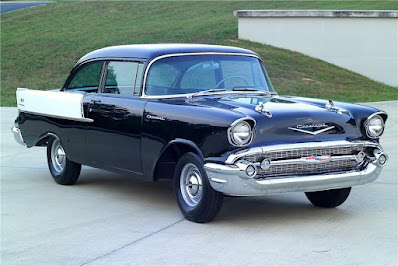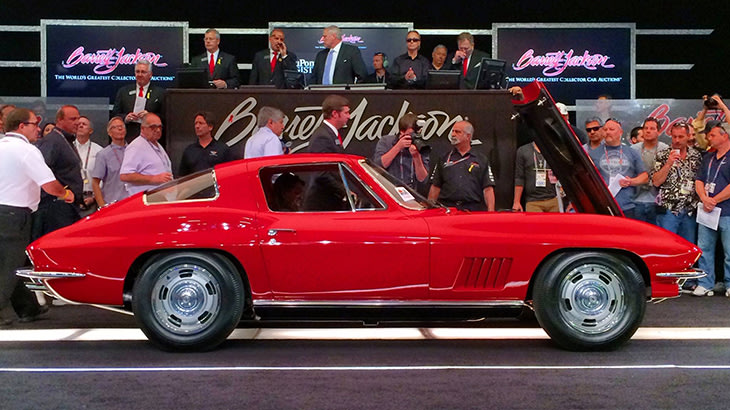How Did the 1957 Chevy Come About?
It starts with Chevy's need for change.
For the first time since 1918, the car company was willing to offer a
V8 in its 1955 version, and with that V8, Chevy thought it would be a
good time to get rid of the shoe-box look that they were recently
using and try something different.
Chevrolet Chief Designer, Ed Cole, wanted to get rid of the shoe-box look by 1956 and have a whole new look for 1957. Unfortunately, things didn't go as planned, the new
look never launched and they would have to make do with the shoe-box
style for one more year, but with big changes.
To help differentiate the '57 from
'55 and '56, Chevy decided to make some changes. And to handle those changes, the task was handed over to Harley J. Earl. Earl had already had huge styling successes under his belt that not only worked out for GM, but also influenced the automotive world as a whole.
These changes would be widely ridiculed by Earl's co-workers, automotive experts, and anyone and everyone who just couldn't see his vision the way he did.
'57 Chevy Dramatic Transformation
Some
of the changes were: A new dashboard, a reshaped windshield, sealed
cowl, and 15-inch rims to replace the 16-inch rims. Also, Chevy
designers relocated the air-ducts to the headlights, which gave the
car the big distinctive chrome look in the front. And then Earl added the iconic quarter-panel fins to the rear to help make the
Chevy six inches longer, ultimately giving the Chevy the lowered look
that everyone recognizes today.
Other intriguing things that
were new with the '57 were a lighter front-end, a bigger engine bay, and new drivetrain options that included a fuel-injection system and
a three-speed Hydra-Matic transmission. A dual exhaust was offered
with all V8 options for a little more horsepower but more so
for the cool sound that it would give the Chevy.
In commercials,
magazine ads, and on billboards, the Chevy motto was always the same:
"Chevy Puts The Purr Back Into Performance."
A 1957 Chevrolet Coupe And Convertible For Everyone
Different
trim options helped make the car more affordable for the average
family and classy enough for those who wanted the feel of something a
little more luxurious.
Trim Models Were As Followed:
Base:
150 Series
Base: 210 Series
Del Ray: 210 Series
Base: Bel
Air
Convertible: Bel Air
Nomad: Bel Air (station wagon)
El
Morocco: custom hand-built to mimic a Cadillac
Each version
was available in a two-door or four-door body style. The base "150"
series with an in-line six was not only priced very well for
consumers on a budget but also did very well when it came to gas
mileage compared to the V8s.
As you went up in models, you went up in
comfort and class and, of course, in price. The Bel Air and Bel
Air convertible was the most popular and expensive models, and in
today's market, it is the most wanted by all collectors and car
enthusiast alike, even if you're not a Chevy fan, you've probably wished you had a '57 at one point or another.
Option Up
Each version
had options that could be ordered up to make the car more comfortable
and luxurious. Some of those options were air-conditioning, power brakes, power steering, a padded
dashboard, power windows, and power seats were all available and
offered as options on most all trim models.
Also, a signal-seeking radio with a power antenna
could be purchased along with a separate speaker that could be placed
in the back, and at that time, that's what automotive companies called surround sound. The
"automatic-eye" was another new option. The automatic-eye was attached to your dashboard and could detect on-coming traffic and
dim your headlights automatically, high-tech for 1957.
One of the things that played a part in making the '57
Chevy so desirable was the bigger engine bay it came with. This was
important because it made room for the big-block engines that Chevy
was making for racing at the time. As drag racing became more popular
and going fast was the thing to do, having a '57 Chevy that could
accept Chevy's big-block engines with virtually no fabrication
required was a huge plus to the go-fast racing enthusiast.
Even
without the big blocks, you could still make plenty of power by
opting for what Chevy called the Power-Pack (283 cubic inch engine
with solid lifters, a 4 barrel carb, and dual exhaust), which would
make 275 horsepower right off the showroom floor.
Although the 283 cubic
inch motor would make 283-hp with fuel injection, that option was
often overlooked by consumers at the time because very few people
knew how to work on fuel injection setups. Even mechanics were having
problems working on the new fuel-injection system. So, if you were
buying the car to modify it and or race it, the Power-Pack option was
a much smarter way to go.
The odd thing about these desirable
collector cars is that in 1957 the sales of Ford's '57 model ended up
out-selling the Chevy. Maybe it was the 1957 Chevy's bold chrome
front-end or the rear-fins that threw consumers off. Maybe it was the
introduction of the fuel injection and the 3-speed Hydra-Matic
transmission - both of which consumers were skeptical about. Whatever
the case was, by the time the '80s rolled around, these were considered
one of the most, if not the most, collectible cars around.
Worth Every Penny
Nowadays, a
meticulously restored '57 Chevy Bel-Air can go for around $100,000.00 or
more, and a seller could catch even more for a convertible in the
same condition. But if you are thinking about buying one, you will
want to be careful
and maybe even seek some professional help before doing so. There are
a lot of replicas out there, and it can be very easy to be fooled.

